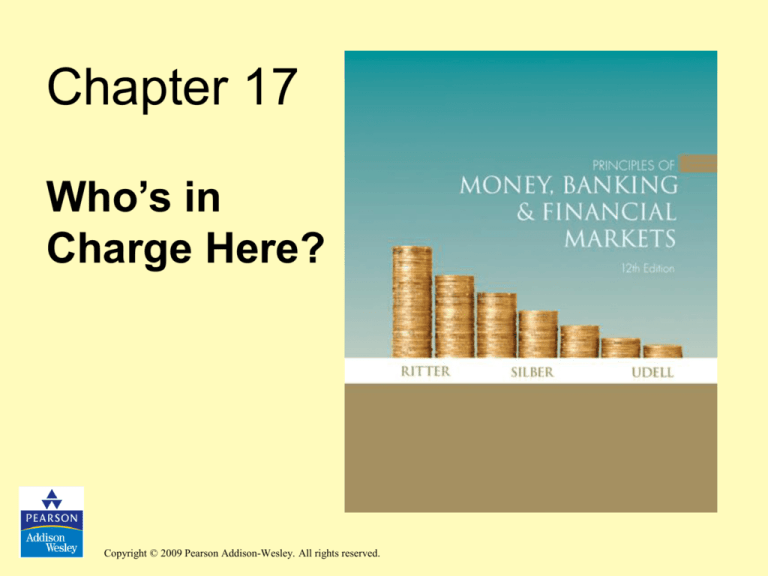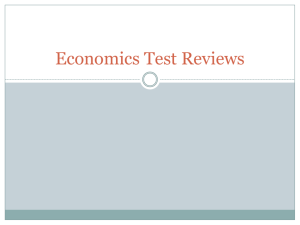
Chapter 17
Who’s in
Charge Here?
Copyright © 2009 Pearson Addison-Wesley. All rights reserved.
Learning Objectives
• Explain the intent of Congress when it
established the structure and purpose of the
Federal Reserve System
• Describe how the structure of the Federal
Reserve has evolved over time
• Analyze the controversies and benefits regarding
central bank independence
Copyright © 2009 Pearson Addison-Wesley. All rights reserved.
17-2
Introduction
• Monetary policy is the responsibility of the
Federal Reserve
• Basic question—“to whom is the Federal
Reserve responsible?”
• Although the President appoints the seven
members of the Board of Governors, the Fed is
not responsible to executive branch
Copyright © 2009 Pearson Addison-Wesley. All rights reserved.
17-3
Introduction (Cont.)
• Congress created Fed in 1913 and has sole
authority to alter its mandate
• Since a large number of commercial banks are
members of Fed, it has been suggested the Fed is
answerable to private banks that are members
Copyright © 2009 Pearson Addison-Wesley. All rights reserved.
17-4
Formal Structure of the Federal
Reserve System
• Organization of the Fed is an excellent example
of decentralization and blending of
public/private authority
• Power is deliberately widely diffused so no
person, group, or sector can exert leverage to
dominate monetary policy
Copyright © 2009 Pearson Addison-Wesley. All rights reserved.
17-5
Formal Structure of the Federal
Reserve System (Cont.)
• Organization
– Figure 17.1 shows the formal structure of the Federal
Reserve system
– Board of Governors
• 7 members appointed by US President with Senate approval for 14
year terms
• No two members from same Federal Reserve district
• Chairman of Board—selected by President from Board with 4 year
term that does not coincide with presidential term
Copyright © 2009 Pearson Addison-Wesley. All rights reserved.
17-6
FIGURE 17.1 The formal structure and policy
organization of the Federal Reserve system.
Copyright © 2009 Pearson Addison-Wesley. All rights reserved.
17-7
Formal Structure of the Federal
Reserve System (Cont.)
• Organization (Cont.)
– Board of Governors (Cont.)
• Independent of congressional appropriations process
• Partly exempt from audit by General Accounting Office
since operating funds come from earnings of the 12
regional banks
Copyright © 2009 Pearson Addison-Wesley. All rights reserved.
17-8
Formal Structure of the Federal
Reserve System (Cont.)
• Organization (Cont.)
– Regional Banks
• Figure 17.2—12 regional Federal Reserve banks dispersed
throughout the nation
• Technically each regional bank is privately owned by member
banks—the very banks the regional banks are charged with
supervising and regulating
• Member banks own stock in regional bank
• Member banks elect 6 of 9 directors of their regional bank with the
remaining 3 appointed by Board of the Federal Reserve
Copyright © 2009 Pearson Addison-Wesley. All rights reserved.
17-9
FIGURE 17.2 The Federal Reserve
System.
Copyright © 2009 Pearson Addison-Wesley. All rights reserved.
17-10
Formal Structure of the Federal
Reserve System (Cont.)
• Organization (Cont.)
– Regional Banks (Cont.)
• Nine directors choose the president of their Federal
Reserve bank, subject to the approval of the Board of
Governors
• Each regional bank selects a representative to serve on the
Federal Advisory Council which makes
recommendations regarding conduct of monetary policy
Copyright © 2009 Pearson Addison-Wesley. All rights reserved.
17-11
Formal Structure of the Federal
Reserve System (Cont.)
• Organization (Cont.)
– Legal authority of Fed
• Diffused with respect to the execution of monetary policy
• Reserve Requirement
– Board of Governors sets the reserve requirements on bank
deposits
– These rates are subject to limits imposed by Congress
Copyright © 2009 Pearson Addison-Wesley. All rights reserved.
17-12
Formal Structure of the Federal
Reserve System (Cont.)
• Organization (Cont.)
– Legal authority of Fed(Cont.)
• Federal Open Market Committee [FOMC]
– Composed of the seven members of Board plus five of regional bank
presidents
– The president of the New York regional bank is a permanent member of
the FOMC
– Therefore, the four remaining seats are rotated annually among the
remaining eleven regional banks
– Responsible for directing open market operations (buy/sell U.S.
government securities) which are executed by the Federal Reserve Bank
of New York
Copyright © 2009 Pearson Addison-Wesley. All rights reserved.
17-13
Formal Structure of the Federal
Reserve System (Cont.)
• Organization (Cont.)
– Legal authority of Fed (Cont.)
• Discount rates
– “Established” every 2 weeks by directors of the regional banks
– Subject to “review and determination” of Board of Governors
– Confusion as to where final authority and responsibility lie
Copyright © 2009 Pearson Addison-Wesley. All rights reserved.
17-14
The Realities of Power
• Figure 17.3 details the realities of power within the
Federal Reserve system
• Chairman of the Board of Governors of Federal
Reserve
– Dominant figure in formation and execution of monetary
policy
– Most influential member of the FOMC
– Recognized as the voice of the Fed
– Chairman is embodiment of US central bank
Copyright © 2009 Pearson Addison-Wesley. All rights reserved.
17-15
FIGURE 17.3 The realities of the power
within the Federal Reserve System.
Copyright © 2009 Pearson Addison-Wesley. All rights reserved.
17-16
The Realities of Power (Cont.)
• Evolution of power of the Fed
– Responsibility for monetary policy has become centralized
and concentrated in Washington
– The Federal Reserve was first established as a passive
service agency
•
•
•
•
Supplying currency
Clearing checks
Providing discount facility
No idea of monetary policy as an active countercyclical force
Copyright © 2009 Pearson Addison-Wesley. All rights reserved.
17-17
The Realities of Power (Cont.)
• Evolution of power of the Fed (Cont.)
– Shifting role of central bank
• Shifted from passive accommodation to active
regulation
• Rise in power of central bank and decline in role of
regional banks
• Consider central bank as headquartered in Washington
with 12 field offices
Copyright © 2009 Pearson Addison-Wesley. All rights reserved.
17-18
The Realities of Power (Cont.)
• Evolution of power of the Fed (Cont.)
– Shifting role of central bank (Cont.)
• Power of the Board’s professional staff of economic
experts and advisers
–
–
–
–
Long tenure with the Fed
Familiarity with history of the Fed
Expertise in monetary analysis
Exert significant influence on ultimate decision-making process
Copyright © 2009 Pearson Addison-Wesley. All rights reserved.
17-19
The Realities of Power (Cont.)
• Power of the FOMC
– Statutory authority is confined to directing open market
operations
– However, all policy matters are reviewed at FOMC meetings
• Role of member banks
– They do “own” their regional bank—mostly symbolic
– Major voice in electing directors of regional banks who have
largely ceremonial responsibilities
Copyright © 2009 Pearson Addison-Wesley. All rights reserved.
17-20
The Problem of Federal Reserve
Independence
• Federal Reserve is a creature of the Congress
– Constitution of US gives Congress power to “coin
money and regulate the value thereof”
– The Federal Reserve was created in 1913 to
administer this responsibility of Congress
Copyright © 2009 Pearson Addison-Wesley. All rights reserved.
17-21
The Problem of Federal Reserve
Independence (Cont.)
• Federal Reserve is a creature of the Congress
(Cont.)
– Congress requires periodic accountability by Fed
and can amend Federal Reserve Act at any time
– Essentially, Congress has given the Fed a broad
mandate to regulate monetary system
– Let monetary authorities pursue this objective on
their own and to the best of their abilities
Copyright © 2009 Pearson Addison-Wesley. All rights reserved.
17-22
The Problem of Federal Reserve
Independence (Cont.)
• Congressional concern over status of FED
– Concern over freedom from congressional
appropriations and exemption from government
audit
– Questioning of the Fed’s handling of monetary
policy—political differences
– Complain Fed has not done a good job and perhaps
Congress should establish guidelines to limit
discretion of Fed
Copyright © 2009 Pearson Addison-Wesley. All rights reserved.
17-23
The Problem of Federal Reserve
Independence (Cont.)
• Relationship between Federal Reserve and
the President
– Should Fed be responsible to the President?
– Monetary policy is one component of
administration’s total economic program and should
be coordinated at highest executive level
– Placing Fed under executive control might invite
excessive money creation and inflation
Copyright © 2009 Pearson Addison-Wesley. All rights reserved.
17-24
The Problem of Federal Reserve
Independence (Cont.)
• Relationship between Federal Reserve and the
President (Cont.)
– Figure 17.A1 demonstrates the global relationship between
central bank independence and inflation
– The more independent the central bank—lower inflation
– Might sacrifice monetary stability to government’s revenue
needs—printing money
– The sole purpose of an independent monetary authority is
to forestall the natural propensity of governments to
resort to inflation
Copyright © 2009 Pearson Addison-Wesley. All rights reserved.
17-25
Figure 17.A1 Central Bank
Independence and Inflation
Copyright © 2009 Pearson Addison-Wesley. All rights reserved.
17-26









